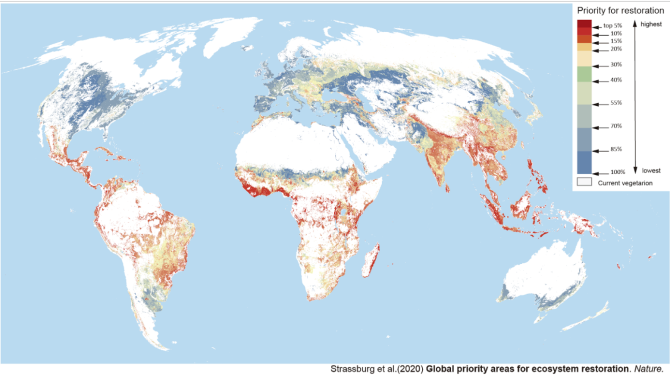
News
Restoring part of world’s ecosystems could stave off extinctions and absorb carbon
Restoring thirty percent of the world’s ecosystems in priority areas could stave off more than seventy percent of projected extinctions and absorb nearly half of the carbon built up in the atmosphere since the Industrial Revolution. As the world focuses on dual crises of climate change and biodiversity loss, a landmark report, published in Nature, is the first of its kind to pinpoint the ecosystems that should be restored for the biggest climate and biodiversity benefits, and at the lowest cost, an international research team reveals this week.
Rescue, restore and protect
Returning specific ecosystems in all continents worldwide that have been replaced by farming to their natural state would rescue the majority of land-based species of mammals, amphibians and birds under threat of dying out while soaking up more than 465 billion tons of carbon dioxide, the new study reveals.
Restoring and protecting 30% of the priority areas identified in the study, together with protecting ecosystems still in their natural form, would reduce carbon emissions equivalent to 49% of all the carbon that has built up in our atmosphere over the last two centuries. Some 27 researchers from 12 countries, led by Brazilian researchers, contributed to the report, which assesses forests, grasslands, shrublands, wetlands and arid ecosystems.
“Pushing forward on plans to return significant sweeps of nature to a natural state is critical to preventing ongoing biodiversity and climate crises from spinning out of control,” says the lead author Bernardo Strassburg. In the Nature study Global priority areas for ecosystem restoration, he says. “We show that if we’re smarter about where we restore nature, we can tick the climate, biodiversity and budget boxes on the world’s urgent to-do list.”
Cost-effective restoration
By identifying precisely which destroyed ecosystems worldwide should be restored to deliver biodiversity and climate benefits at a low cost, without impact on agricultural production, the study is the first of its kind to provide global evidence that where restoration takes place has the most profound impact on the achievement of biodiversity, climate and food security goals. According to the study, restoration can be 13 times more cost-effective when it takes place in the highest priority locations.

Wageningen researcher Catarina Jakovac of the Forest ecology and management group at Wageningen University & Research adds: “Our analysis show that around 70% of the areas considered priority at the global level are also priority at national levels. These areas are located in developing tropical countries that might not have the means to finance all targeted restoration. Therefore, intensification of international cooperation is crucial to support restoration actions and guarantee a positive impact at both local and global levels.”
Dire warnings by UN on species lost
The new report builds on the UN’s dire warnings that we’re on track to lose 1 million species in coming decades and that the world has mostly failed in its efforts to reach globally-set biodiversity targets in 2020, including the goal to restore 15% of ecosystems worldwide. Nations are re-doubling efforts to stave off mass extinctions in the leadup to the Convention on Biological Diversity COP15 in Kunming, China, in 2021, when a global framework to protect nature is expected to be signed. The new Nature report, which includes a co-author from the CBD, will inform the discussion around restoration and offer insight into how reviving ecosystems can help tackle multiple goals.
PLANGEA platform
Using a sophisticated multi-criteria optimization platform called PLANGEA— a mathematical approach that finds “slam dunk” solutions to address multiple problems— and mapping technologies, the researchers assessed 2,870 million hectares of ecosystems worldwide that have been converted to farmland. Of these, 54% were originally forests, 25% grasslands, 14% shrublands, 4% arid lands and 2% wetlands. They then evaluated these lands based on three factors, or objectives (animal habitats, carbon storage and cost-effectiveness) to determine which swathe — whether it’s five, 15 or 30% — of lands worldwide would deliver the most benefits for biodiversity and carbon at the lowest cost when restored.
Researchers were further able to identify a global-level, multiple-benefits solution — unconstrained by national boundaries — that would deliver 91% of the potential benefit for biodiversity, 82% of the climate mitigation benefit, and reduce costs by 27% by focusing on areas with low implementation and opportunity costs. When researchers looked at the benefits if the restoration were to take place at the national level — which means that each country would restore 15% of its forests — they saw a reduction in biodiversity benefits by 28% and climate benefits by 29%, a rise in costs by 52%.
Responding to fears that restoring ecosystems will encroach on the land needed for crop production, researchers calculated how many ecosystems could be revived without cutting into food supplies. They found that 55%, or 1,578 million hectares, of ecosystems that had been converted to farmlands, could be restored without disrupting food production. This could be achieved through the well-planned and sustainable intensification of food production, together with a reduction in food waste and a shift away from foods such as meat and cheese, which require large amounts of land and therefore produce disproportionate greenhouse gas emissions.
National and local approach
The approach developed is already supporting implementation at national and local scales. It’s attracting the attention of policy makers, NGOs and the private sector due to the substantial cost-benefit increase of restoration efforts. “We intend to help restoration achieve massive scales by aligning socioecological and financial interests, simultaneously increasing impacts for nature and people while improving returns and reducing risks for investors,” said Strassburg.
Overall, the study provides compelling evidence to policymakers seeking affordable, efficient ways to meet United Nations goals around biodiversity, climate and, additionally, desertification, that restoration, when well-coordinated and carried out in combination with the protection of intact ecosystems and the better use of agricultural lands, is an unmatched — though currently underused — solution.